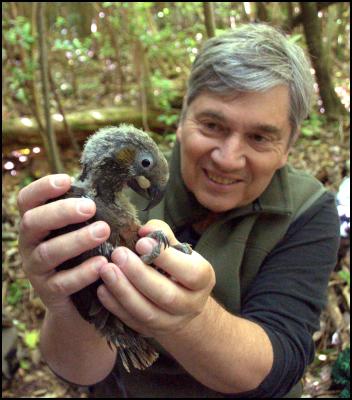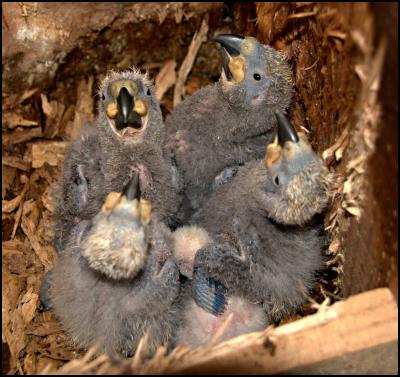LO-V against the odds at ZEALANDIA
LO-V against the odds at ZEALANDIA

A young kākā chick runt at ZEALANDIA - once presumed so close to death his nest-minders had a body bag ready for him - has delighted conservationists at the ecosanctuary by hanging on to life - with some sisterly help from his nestmates!
Aroha (named after the Māori word for love) was banded with the colours Lime over Orange on the left leg, and laVender on the right (LO-V). Lavender being this year’s cohort colour for the species.
“Most of the band combos this year don’t make good acronyms but that one had to go to a very special bird” said volunteer kākā nest monitor coordinator Judi Lapsley Miller. “We named him Aroha and I’m sure his sisters would agree with the sentiment – they are very protective of him.”
The runt, who is too young to be sexed but has so far been referred to as a “he”, came from the last, unusually late egg to be laid in a clutch of five.
“Kākā usually lay an egg every second day until they get three, and then start incubating. They then lay up to two more as insurance policies, continuing on the every-second-day cycle. So it's usual to have a laggard in the nest, but it's usually only up to 4 days younger than the others and soon catches up” said Lapsley Miller.
Staff assumed the fifth egg was a dud. But to everyone’s surprise, in early December the small chick was spotted.

“The fourth (which
we’d usually refer to as the runt) soon caught up to the
rest, but the fifth (Aroha) struggled. We all assumed the
worst - that it was too much younger and wouldn't be able to
compete for food and would die” said Lapsley
Miller.
Voluntary nest monitors Bill Beale and Elizabeth Ridder were checking the progress of the clutch.
“Initially it wasn't thriving. I would turn up for nest checks with bags and gloves at the ready to remove the body. But its siblings were very protective of it and somehow it managed to start putting on weight and feathers” said Beale.
Around 7 days younger than his oldest sibling, Aroha is also developmentally further behind, having failed to thrive in the first few weeks but doing better later on. When microchipped on 15 January he was “feisty and interested in the world”, but still much smaller than a normal kaka chick.
Aroha is not out of the woods yet. Once the older chicks fledge the mother will still be feeding them all and if they move too far away from the nest box, she may have trouble provisioning everyone.
Conservation Manager Raewyn Empson said “Based on survival of chicks that have fledged from nestboxes in the sanctuary in previous years this chick has at least a 50% chance of survival, possibly higher”
… will LO-V find a way?
ends


 NZEI Te Riu Roa: Mandated Single Approach To Reading Will Not Work
NZEI Te Riu Roa: Mandated Single Approach To Reading Will Not Work The Conversation: Could The School Phone Ban Work?
The Conversation: Could The School Phone Ban Work? Public Health Communication Centre: To Avoid A Measles Epidemic, Aotearoa Must Close The ‘Immunity Gap’
Public Health Communication Centre: To Avoid A Measles Epidemic, Aotearoa Must Close The ‘Immunity Gap’ Heritage New Zealand: Kid-friendly Archaeology Resource Kit Launched As Part Of Archaeology Week
Heritage New Zealand: Kid-friendly Archaeology Resource Kit Launched As Part Of Archaeology Week Tatai Aho Rau Core Education: Cyber Skills Programme For Tamariki Recognised At Māori Language Awards
Tatai Aho Rau Core Education: Cyber Skills Programme For Tamariki Recognised At Māori Language Awards Waitaha Kapa Haka: Waitaha-South Island Kapa Haka Celebrates 60th Anniversary
Waitaha Kapa Haka: Waitaha-South Island Kapa Haka Celebrates 60th Anniversary